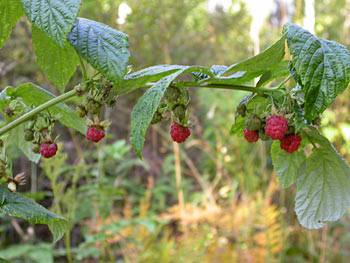Relatives
Rubus idaeus L. - European raspberry.
Taxonomic position.
Family Rosaceae Juss. genus Rubus L.Synonyms.
Rubus cericeus Gilib., Batidaea idaea (L.) GreeneMorphology and biology.
Semishrub, 0.5-1.8 m high. First-year offshoots are green, fruitless, with thin straight aciculae and glaucousness. Second-year offshoots are somewhat lignified, yellowish, fruit-bearing; branches with leaves are green. Leaves are odd-pinnate, consisting of 3-5 (7) leaflets; stipules are thread-like; petioles are grooved from above. Leaflets have white tomentose underside, but from above they are almost naked, rather finely and irregularly serrate. Flowers are assembled in axillary oliganthous racemes and a terminal corymbose-paniculate inflorescence. Petals are white. Peduncles and pedicels are covered with dispersed setae without glandules. There are 5 sepals; they are gray-green, deflected. Stamina and carpels are plentiful. Fruits are globular red or, less frequently, yellow polydrupes, 12-18 mm long and 10-14 mm wide, easily detachable from their white cylindrical-conical receptacles; drupes are small (approximately 3 mm), juicy, velvety-downy. Entomophilous, ornito- and zoochore. Propagated by seed, root suckers or softwood cuttings. Blossoms in June, bears fruit in July/August. 2n=14.Distribution.
This plant has a disjunctive area of distribution, whose major part engulfs the forest zone and adjacent forest-steppe areas of the European part of the ex-USSR and Western Siberia; Crimea (infrequent in the Crimean mountains); Eastern Siberia (Central Siberian Plateau - riverbanks of the Uda and the Artumey; vicinities of the Chekan River; southern shore line of Baikal); Caucasus (Greater and Lesser Caucasus, Talysh); Middle Asia (Saur, Tarbagatai, Dzungarian Ala Tau, Trans-Ili Range, etc.); Scandinavia; Central and Atlantic Europe; Mediterranean region; Asia Minor; Mongolia; Japan; China; North America; Australia (naturalized).Ecology.
Mesophyte. Grows in sparse mixed forests and groves, on forest edges, glades and clearings, over gullies and meadows, along riverbanks, as single plants or in groups, inhabiting plains and mountains, both in the forest zone and forest mountain belt. Occurs on rich moist soils, poorly tolerates droughts, has low winter-hardiness.Utilization and economic value.
Food and medicinal. Long ago known as a cultivated plant; generally reputed as one of the most valuable berry shrubs. The ancestor of nearly all raspberry cultivars. Fruits are consumed fresh or used to prepare jams, confectionary, liqueurs, compotes and wines.References:
Atlas of the areas of distribution and resources of medicinal plants in the USSR.1983. Tolmachev.s A.I. (ed.). Moscow: Principal Office of Geodesy and Cartography, p.262. (inRussian).
Brezhnev, D.D., Korovina, O.N. 1981. Wild relatives of cultivated plants in the flora of the USSR. Leningrad: Kolos, pp.210-211. (in Russian).
Sokolov, S.I., Svjaseva, O.A., Kubli, V.A. 1980. Areas of distribution of trees and shrubs in the USSR. vol.2. Leningrad: Nauka, p.80 (in Russian).


